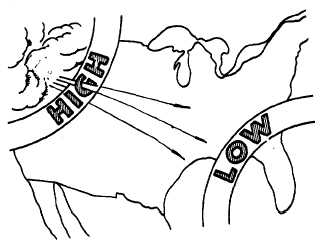TM 5-4240-501-14&P
THEORIES OF OPERATION
Carburetion
CARBURETION
The basic purpose of a carburetor is to produce a
mixture of fuel and air on which an engine will operate; to
do so is relatively easy. However, producing economical
fuel consumption and smooth engine operation over a
wide range of speeds creates the need for a more
complicated mechanism than a mere mixing valve.
There is an additional problem in that the price of such a
carburetor must be held in proportion to the price of the
engine. The price of a Briggs & Stratton engine is not
much greater than the price of the carburetor on an
automobile.
Atmospheric Pressure
Figure 12.
Keeping this in mind, we must utilize the force of
atmospheric pressure and the principles of the venturi
and the airfoil.
Atmospheric pressure, while it may vary slightly due to
altitude or temperature, is a constant potent force which
tends to equalize itself in any given area. It is the weight
of the air in the atmosphere pushing down and outward
in all directions and is commonly figured as between 13
and 15 pounds per square inch. We know that air
moves from a high pressure area to a low pressure area.
To use this force of atmospheric pressure in a
carburetor, we artificially create low pressure areas and
thus obtain movement either of air or of intervening fuel.
We will show you how a little later.
The greater the difference in pressure between the two
areas the greater the velocity or the greater the distance
we can raise the fuel.
In the interest of brevity we often use the terms vacuum
or suction when we actually mean the difference in
pressures.
Venturi
What is a venturi ? Have you ever noticed that the wind
blowing through a narrow space between two buildings
always seems to be much stronger than in the open? In
other words, the velocity is greater. The same thing can
be seen in a river. The current is always faster in a
narrow, shallow place than in the deep wide pools.
In a fashion, these narrow places are venturi is. The
great bulk of air or water suddenly forced through a
constricted space has to accelerate in order to maintain
the volume of flow.
This is the way a venturi is placed in a carburetor. Fig.
13. The shape is carefully designed to produce certain
air flow patterns.
Figure 13.
7
14



